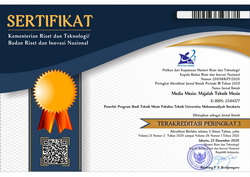THE IMPACT OF CHROME PLATED COPPER CATALYTIC CONVERTERS ON ENGINE PERFORMANCE WAS EVALUATED BY CHASSIS DYNAMOMETER EXPERIMENT
Sudirman Rizki Ariyanto(1), Retno Wulandari(2), Suprayitno Suprayitno(3*), Muhammad Yandi Pratama(4), Ata Syifa’ Nugraha(5)(1) Faculty of Engineering, Department of Mechanical Engineering Universitas Negeri Malang
(2) Faculty of Engineering, Department of Mechanical Engineering Universitas Negeri Malang
(3) Faculty of Engineering, Department of Mechanical Engineering Universitas Negeri Malang
(4) Faculty of Engineering, Department of Mechanical Engineering Universitas Negeri Malang
(5) Faculty of Engineering, Department of Mechanical Engineering Universitas Billfath
(*) Corresponding Author
Abstract
Keywords
Full Text:
PDFReferences
Indonesian Central Statistics Agency, “The Growth of Motor Vehicles in Indonesia,” 2021. https://www.bps.go.id/linkTableDinamis/view/id/1133 (accessed Apr. 11, 2020).
S. P. Jena, S. K. Acharya, H. C. Das, P. P. Patnaik, and S. Bajpai, “Investigation of the effect of FeCl 3 on combustion and emission of diesel engine with thermal barrier coating,” Sustain. Environ. Res., vol. 28, no. 2, pp. 72–78, Mar. 2018, doi: 10.1016/j.serj.2017.10.002.
Y. Li, Y. Wang, Y. Zi, and M. Zhang, “An Enhanced Data Visualization Method for Diesel Engine Malfunction Classification Using Multi-Sensor Signals,” Sensors, vol. 15, no. 10, pp. 26675–26693, Oct. 2015, doi: 10.3390/s151026675.
W. Warju, S. R. Ariyanto, A. S. Nugraha, and M. Y. Pratama, “The Effectiveness of the Brass Based Catalytic Converter to Reduce Exhaust Gas Emissions from Four-stroke Motorcycle Engines,” in International Joint Conference on Science and Engineering 2021 (IJCSE 2021) The, 2021, vol. 209, no. Ijcse, pp. 417–422, doi: 10.2991/aer.k.211215.071.
A. Ghofur, Soemarno, A. Hadi, and M. D. Putra, “Potential fly ash waste as catalytic converter for reduction of HC and CO emissions,” Sustain. Environ. Res., vol. 28, no. 6, pp. 357–362, Nov. 2018, doi: 10.1016/j.serj.2018.07.003.
F. Patel and S. Patel, “La1-xSrxCoO3 (x=0, 0.2) Perovskites Type Catalyst for Carbon Monoxide Emission Control from Auto-Exhaust,” Procedia Eng., vol. 51, pp. 324–329, 2013, doi: 10.1016/j.proeng.2013.01.044.
R. Bagus Irawan, P. Purwanto, and H. Hadiyanto, “Optimum Design of Manganese-coated Copper Catalytic Converter to Reduce Carbon Monoxide Emissions on Gasoline Motor,” Procedia Environ. Sci., vol. 23, pp. 86–92, 2015, doi: 10.1016/j.proenv.2015.01.013.
H.-J. Sun et al., “Effect of transition metals (Cr, Mn, Fe, Co, Ni, Cu and Zn) on the hydrogenation properties of benzene over Ru-based catalyst,” Appl. Catal. A Gen., vol. 464–465, pp. 1–9, Aug. 2013, doi: 10.1016/j.apcata.2013.05.021.
R. B. Irawan, P. Purwanto, and H. Hadiyanto, “Optimum Design of Manganese-coated Copper Catalytic Converter to Reduce Carbon Monoxide Emissions on Gasoline Motor,” Procedia Environ. Sci., vol. 23, pp. 86–92, 2015, doi: 10.1016/j.proenv.2015.01.013.
Y. Wang, D. Yang, S. Li, L. Zhang, G. Zheng, and L. Guo, “Layered copper manganese oxide for the efficient catalytic CO and VOCs oxidation,” Chem. Eng. J., vol. 357, pp. 258–268, Feb. 2019, doi: 10.1016/j.cej.2018.09.156.
R. Manojkumar, S. Haranethra, M. Muralidharan, and A. Ramaprabhu, “I.C. Engine emission reduction using catalytic converter by replacing the noble catalyst and using copper oxide as the catalyst,” Mater. Today Proc., Apr. 2020, doi: 10.1016/j.matpr.2020.02.804.
S. R. Ariyanto, R. Wulandari, Suprayitno, and P. I. Purboputro, “Pengaruh Metallic Catalytic Converter Tembaga Berlapis Chrome Dalam Menurunkan Emisi Gas Buang Mesin Sepeda Motor Empat Langkah,” J. Media Mesin, vol. 23, no. 1, pp. 44–51, 2022, doi: 10.23917/mesin.v23i1.16604.
SAE J1349, Engine Power Test Code-Spark Ignition and Compression Ignition-Net Power Rating. Warrendale: SAE International, 2004.
E. F. Obert, Internal Combustion Engine dan Air Pollution. New York: Harper & Row, 1973.
T. V. Loskutova, I. S. Pogrebova, V. G. Khyzhnyak, M. M. Bobina, and N. S. Nikitina, “Protective properties of a new type coatings involving titanium, chromium, aluminum,” Mater. Today Proc., vol. 6, pp. 202–211, 2019, doi: 10.1016/j.matpr.2018.10.095.
A. S. Hamdy Makhlouf and R. Rodriguez, “Bioinspired smart coatings and engineering materials for industrial and biomedical applications,” in Advances in Smart Coatings and Thin Films for Future Industrial and Biomedical Engineering Applications, Elsevier, 2020, pp. 407–427.
A. G. Bell, Modern Engine Tuning. Haynes Publishing, 1997.
W. Warju, S. R. Ariyanto, N. S. Drastiawati, and M. Nurtanto, “The effect of Titanium Dioxide ( TiO2 ) based metallic catalytic converter on the four-stroke motorcycle engine performance The effect of Titanium Dioxide ( TiO2 ) based metallic catalytic converter on the four-stroke motorcycle engine performance,” J. Phys. Conf. Ser., 2021, doi: 10.1088/1742-6596/1747/1/012031.
M. C. Ozgenel, “Increasing power and torque capability of brushless direct current motor by employing 150-degree conduction mode controlled three-phase voltage source inverter,” Rev. Sci. Instrum., vol. 89, no. 8, p. 085002, Aug. 2018, doi: 10.1063/1.5033957.
M. Bhandwal, M. Kumar, M. Sharma, U. Srivastava, A. Verma, and R. K. Tyagi, “The effect of using the turbulence enhancement unit before the catalytic converter in diesel engine emissions,” Int. J. Ambient Energy, vol. 39, no. 1, pp. 73–77, Jan. 2018, doi: 10.1080/01430750.2016.1237889.
M. Okubo and T. Kuwahara, “Principle and design of emission control systems,” in New Technologies for Emission Control in Marine Diesel Engines, Elsevier, 2020, pp. 53–143.
Article Metrics
Abstract view(s): 712 time(s)PDF: 722 time(s)
Refbacks
- There are currently no refbacks.








